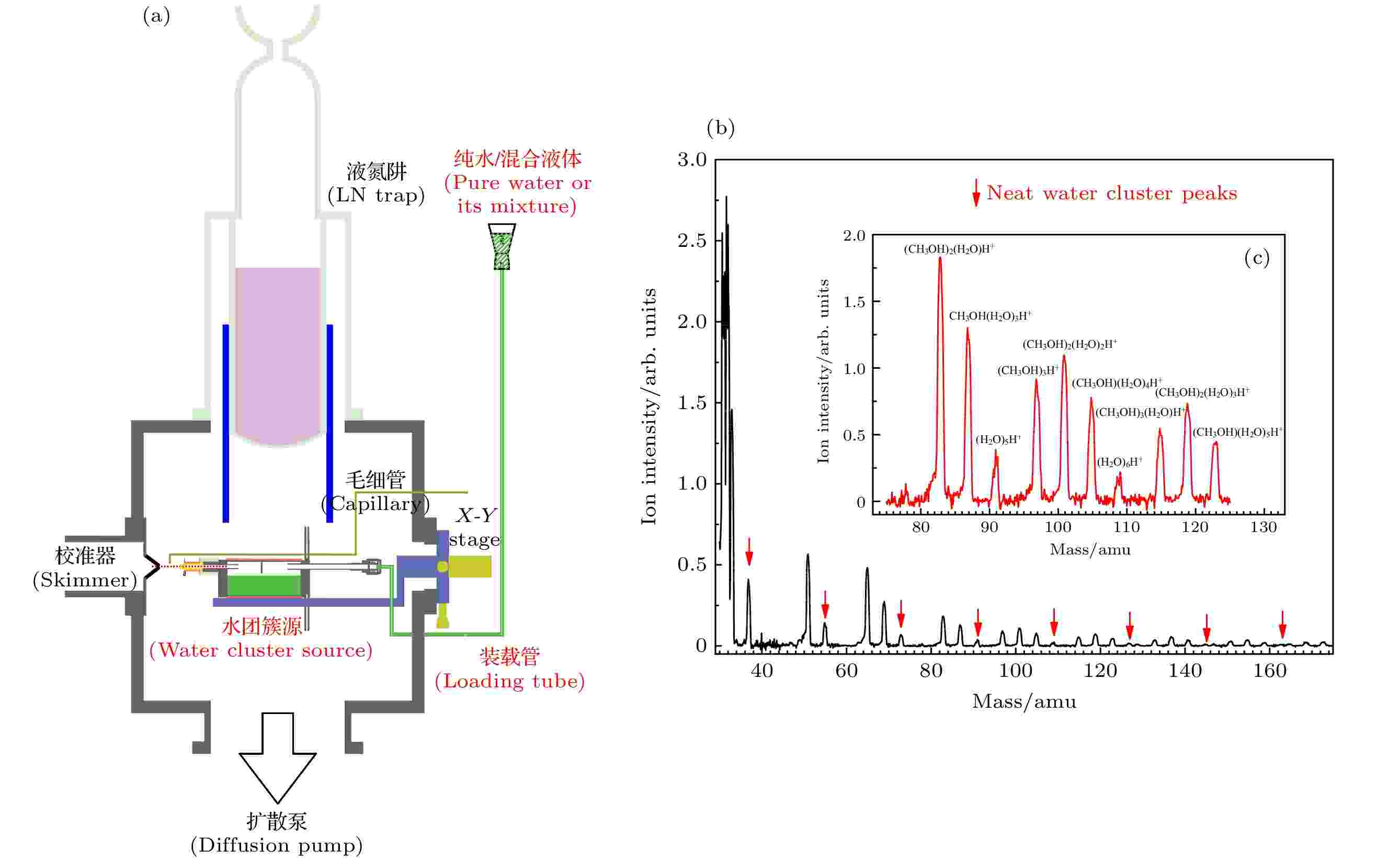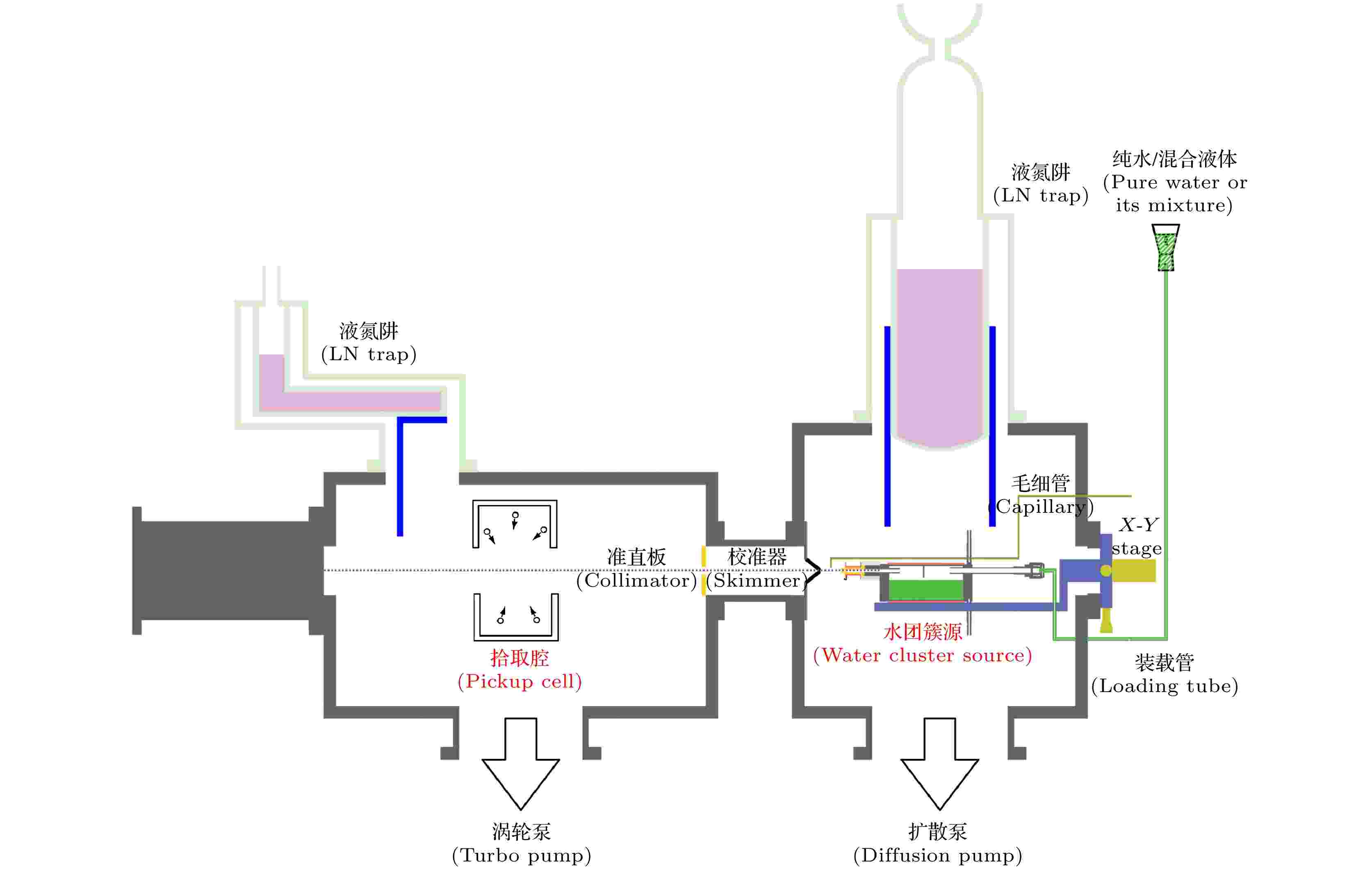全文HTML
--> --> -->其次, 水团簇研究还有利于理解极性溶剂的溶解机制. 水作为自然界中最常见的基本极性溶剂, 水电解酸的理论虽然在1889年前由Arrhenius[25]开创性提出, 并于1903年获得了诺贝尔化学奖, 但科学界仍然有一个待解决的疑惑: 解离一个极性分子, 最少需要几个水分子? 水团簇可作为一种理想的计算机模拟模型来研究分子的解离性质, 以HCl为例, 理论研究给出了至少需要4个水分子来电离HCl分子的结论[26]. 在实验上研究HCl的解离性质, 需获得水团簇和HCl组成的混合系统的稳定结构, 即需要把HCl掺入纯水团簇中. 通常来说, 不同的掺杂方法, 会影响获得的混合水团簇(mixed water clusters)的形成结构, 比如通过氦团簇拾取(pickup)水团簇和外来分子(或原子)的方法, 则可形成低温的混合水团簇, 从而可研究其基态结构等方面性质[27]. 当然, 水团簇还可以与金属原子形成混合的水合离子团簇, 这种水合离子团簇广泛存在于生物体及海洋中, 研究其性质具有重要的作用, 比如水合钠离子团簇在控制血压、细胞通透性、神经元活动和其他躯体功能中具有不可忽视的功能[28]. 另外, 研究者们还利用了钠掺杂水团簇方法, 发展钠掺杂光电子电离技术[29], 通过此种手段可获得具有游离弱束缚状态的电子的混合钠掺杂水团簇, 从而得到具有相对原始尺寸分布的水团簇质谱[30].
可以看出, 水团簇的掺杂可以极大地丰富水团簇的研究范围, 如水团簇和外来分子(HCl, HF, SO2, NH3, CH3OH等)混合可以研究键合、静电作用、电荷转移、交互排斥作用等性质[16,26-27,31-43]. 因此在水团簇科学领域里, 一个非常重要的研究分支, 是通过引入外来分子掺杂纯水团簇以形成混合水团簇. 不管在实验上还是理论上, 都广泛地利用该方法来获得更深入的水团簇性质, 有助于理解极性溶剂的溶解机制, 与外来分子(如NH3和HCl)等聚合的氢键性质, 及水团簇电离性质等方面的研究[31-33]. 正如上文所述, 混合水团簇的研究还可以加深对其结构及质子结合模式的理解. 对于不同性质的研究, 通常也需要依赖于产生混合水团簇的方法. 本综述主要简述掺杂水团簇的方法, 根据研究需要及实验特性, 总结了4种主要的掺杂水团簇的方法.
2
2.1.共膨胀方法
为了更好地阐述该节内容, 本文以美国南加州大学Kresin组的水团簇源腔[27,46]为例, 如图1(a)所示. 水团簇源腔装置包括了水装载系统、水团簇源、校准器、液氮阱、扩散泵、X-Y平台等, 其中水装载系统包含可拆卸的广口瓶、水阀、

 图 1 (a) 水团簇源装置图, 其中标红的3个部分构成了共膨胀掺杂水团簇的基本条件, 即包括可盛入纯水或混合液体的广口瓶、装载管、水团簇源; (b) 实验将甲醇和纯水以约1∶5的体积比混合, 经过超声膨胀, 获得的水-甲醇混合团簇质谱, 尽管甲醇相比于水含量较小, 但是从图上可看出水-甲醇混合团簇的信号却远强于纯水团簇的信号(红色箭头标记处为纯水团簇峰); 插图(c)是75—125 amu质量范围内的质谱放大图[46], 其版权已获得Nature Springer的许可
图 1 (a) 水团簇源装置图, 其中标红的3个部分构成了共膨胀掺杂水团簇的基本条件, 即包括可盛入纯水或混合液体的广口瓶、装载管、水团簇源; (b) 实验将甲醇和纯水以约1∶5的体积比混合, 经过超声膨胀, 获得的水-甲醇混合团簇质谱, 尽管甲醇相比于水含量较小, 但是从图上可看出水-甲醇混合团簇的信号却远强于纯水团簇的信号(红色箭头标记处为纯水团簇峰); 插图(c)是75—125 amu质量范围内的质谱放大图[46], 其版权已获得Nature Springer的许可Figure1. (a) Diagram of water cluster source chamber, in which the three parts marked in red constitute the basic conditions for co-expanding to attain doped water clusters, including a jar that can be filled with pure water or mixed liquid, a loading tube, and a water cluster source. (b) In the experiment, methanol and pure water were mixed in a volume ratio of about 1∶5, and after supersonic expansion, the mass spectrum of the water-methanol mixed cluster was obtained. The content of methanol was much less than water, but the signal of water-methanol mixed clusters is much stronger than that of pure water clusters (the red arrow indicates the pure water cluster peak); The inset (c) is an enlarged drawing of the mass spectrum in the mass range of 75–125 amu[46], which is reprinted by the permission of Nature Springer.
类似地, 若想获得混合水团簇, 则可装载待掺杂物质与纯水形成的混合液体进入水团簇源. 利用PID控制器加热水团簇源, 最终温度需维持源内蒸汽压为3—4个大气压, 混合蒸汽则可通过喷嘴共膨胀冷凝获得混合水团簇. 与探测纯水团簇的步骤相似, 混合水团簇需经过校准器、准直仪、电离器、脉冲电子倍增管、单阈值鉴别器等装置, 最终获得其质谱信号. 例如, 基于共膨胀方法, 装载了甲醇和纯水溶液(体积比为1∶5), 并使水团簇源温度保持在448 K. 随着甲醇和水混合蒸汽的共同膨胀, 获得了混合的水-甲醛团簇质谱, 如图1(b)所示, 其中纯水团簇峰用红色箭头标记, 而其他峰对应于混合的水-甲醇团簇. 尽管甲醇所占比例只有20%, 但是形成的水-甲醇混合团簇比纯水团簇具有更高的强度, 如质谱放大图1(c)所示[46]. 可看出共膨胀方法适用于较高信号强度的混合水团簇的制备, 通常被掺杂的分子或原子处于水团簇的结构内部, 适合混合水团簇的结构特性等研究, 如日本藤井小组[47,48]研究了共膨胀掺杂法制备的水-甲醇混合团簇的结构和质子结合性质. 类似地, 不同的研究组利用共膨胀方法还探究了NH3[31,32], HCl[38], SO2[49], HNO3[50]等极性分子及Ar[51]与水团簇形成的混合团簇, 研究了它们的结构性质及解离的动力学机制等. 对于气体分子的混合, 首先可能需要将纯水加热获得蒸汽, 引入到一个待混合的炉子, 气压小于12 Torr (1 Torr = 133.322 Pa)以防止凝聚, 然后通入外来气体混合膨胀获得混合团簇[49]. 需要强调的是, 尽管共膨胀方法不需要昂贵的搭建成本, 但是其比较适用于低温或易溶解的被掺杂物质, 这样才能形成混合水团簇.
最后简要描述一下水团簇的电离, 它是探测(混合)团簇信号及其性质不可或缺的手段. 从实验团簇科学来讲, 不管是中性纯水团簇还是混合水团簇, 在超声绝热膨胀冷凝后都是中性的, 通常都需要通过电离手段才能被探测. 如中性纯水团簇在电子(或光)电离手段下, 则会形成带电荷的离子纯水团簇, 电离的过程如下:

















2
2.2.拾取方法
拾取方法同样广泛地应用于分子束流方法, 其是获得混合团簇的主要实验手段, 也是丰富团簇科学研究的重要方法. 根据拾取方法的不同, 可以分为拾取腔、毛细管、氦团簇拾取这3种方法用于掺杂水团簇.3
2.2.1.拾取腔
通常拾取腔可位于团簇装置差分次级真空腔, 以本文的水团簇装置为例, 如图2所示[54,55]. 纯的水团簇束流通过具有低密度气体的拾取腔, 则水团簇具有一定的概率拾取外来分子或原子. 需确保拾取腔中被通入的气体流量不能超过腔内涡轮泵的负荷, 否则可能会导致团簇束流被斩断. 根据实验的需要, 可以在拾取腔内通入不同的气体, 如Kresin课题组[56,57]在拾取腔里通入DCl气体, 研究了(H2O)nDCl混合团簇在电子电离下的质谱分布. 近来, Fárník等[58]利用拾取腔方法测量了水-硝酸混合团簇的拾取截面, 并且调研了与极性平流层臭氧消耗有关的卤化氢和氟利昂CF2Cl2在水团簇上的光激发及解离机制. 利用拾取腔的方法, 研究者还研究了不同的气体分子, 如SO2[59], NO (NO2, N2O等)[60], 甚至氨基酸分子[61]等与水形成水团簇的性质. 相比于共膨胀掺杂方法, 拾取腔方法只能让单个分子或者原子被水团簇拾取, 同时这个分子或者原子位于水团簇表面上, 例如, Fárník课题组[29]发展了钠掺杂水团簇的光电离技术, 此技术手段可反映原始水团簇的尺寸分布, 金属钠放置于拾取腔内, 然后被加热以获得钠蒸汽, 被掺杂的钠原子位于水团簇的表面, 并形成一个弱束缚电子, 因此只需要非常低的光子能量就可以将水团簇电离, 从而不会导致水团簇严重分裂[30,54]. 通常单个分子或者原子与水团簇碰撞, 会导致水团簇的飞行方向轻微偏转, 由于水团簇质量较大, 该偏转基本可以忽略不计. 另外由于拾取腔体积相对较大, 通常腔中的外来分子(原子)的密度较低, 它们与水团簇碰撞具有一定的随机性, 并只具有较小的概率被水团簇束流拾取, 而共膨胀方法的外来掺杂分子(原子)蒸汽, 可直接与源中水蒸气混合形成过饱和蒸汽压, 从而实现超声膨胀冷凝获得混合水团簇. 它们与水蒸气在形成混合水团簇过程中具有同等地位, 所以总体来说拾取腔方法获得的混合水团簇信号强度要远远弱于共膨胀的掺杂方法. 图 2 拾取腔通常放置于次级飞行腔, 如图中红色字体标注
图 2 拾取腔通常放置于次级飞行腔, 如图中红色字体标注Figure2. Pickup cell is usually placed in the secondary flight chamber, as marked in red fonts.
正如上文所述, 拾取腔放置于团簇设备差分真空中的次级飞行腔, 相比于水团簇源腔, 次级飞行腔对真空度要求更高, 在设计拾取腔时需要更高的真空技术要求, 另外考虑拾取腔由不锈钢材料及加热装置组成, 所以拾取腔的设计、搭建以及维护成本相对也较昂贵.
3
2.2.2.毛细管
本节将描述另一种水团簇的掺杂方法[46], 即通过一根非常纤细的不锈钢管输运外来气体分子, 称之为毛细管掺杂方法, 如图3所示. 由于该种方法的应用相比于前两种, 相对少见, 因此将以仪器具体描述毛细管掺杂水团簇的方法, 以DCl分子为例: 将一根直径为1/16 inch (1 inch = 2.54 cm)的不锈钢管(类似于毛细管)将其出口挤压成椭圆形状(半长轴ID约2 mm), 并位于喷嘴前方5 mm处, 毛细管的方向垂直向下并指向水团簇束流飞行方向, 如图3(a)所示. 外来分子DCl会扩散流出毛细管, 流速可通过两级压力调节器进行控制, 如可利用美国Swagelok公司的双针阀进行精细调节. 阀门的精确调节能够获得混合簇的最大强度, 通常情况下, 如果水团簇束流信号强度因DCl分子的碰撞而斩波一半时, 则混合团簇的信号最强. 图3(b)是通过毛细管输送DCl分子, 使其与水团簇束流碰撞后所探测到的质谱, 对应的峰有纯水团簇((H2O)4H+, (H2O)5H+, (H2O)6H+, (H2O)7H+)以及与DCl混合的水团簇(H2O)4D+, (H2O)5D+, (H2O)6D+, (H2O)7D+). 相比于共膨胀方法, 混合团簇的信号强度也比较弱, 并且当应用于其他外来极性分子时, 如CH3OH, NH3等, 获得的质谱并没有像图1(b)那样发现混合团簇信号, 如图3(c)和图3(d)所示. 可以看出和DCl极易被水团簇拾取相比, 这些分子似乎很难利用毛细管掺杂方法被水团簇拾取, 背后的物理化学机制仍待进一步研究. 图 3 (a)是毛细管掺杂装置图; 基于毛细管方法, (b)为获得的DCl与水团簇的混合质谱; (c)和(d)分别为CH3OH和NH3掺杂后水团簇的质谱, 这两种分子气体似乎很难应用毛细管方法掺杂进水团簇中. 其中图(b)和(c)引自参考文献[46], 其版权已获得Nature Springer的许可
图 3 (a)是毛细管掺杂装置图; 基于毛细管方法, (b)为获得的DCl与水团簇的混合质谱; (c)和(d)分别为CH3OH和NH3掺杂后水团簇的质谱, 这两种分子气体似乎很难应用毛细管方法掺杂进水团簇中. 其中图(b)和(c)引自参考文献[46], 其版权已获得Nature Springer的许可Figure3. (a) Design diagram of the capillary with the water cluster source. Based on the capillary method, panel (b) is the obtained mixed mass spectrum of DC1 and water clusters; panel (c) and (d) are the mass spectra of water clusters after doped with CH3OH and NH3, respectively. These two molecular gases seem hardly doping into water clusters by the capillary methods. Panels (b) and (c) are cited from Ref. [46], which are reprinted here by the permission of Nature Springer.
在这里值得注意的是, 该方法相比于拾取腔方法, 具有一定的类似性, 同时又有所不同. 如拾取腔中的外来分子的速度方向是随机的, 因此在水团簇拾取了外来分子之后, 会给混合水团簇带来某些未知的纵向飞行速度. 换句话说, 这种不确定性会导致测量的混合水团簇的速度分布可能会相应地变宽, 水团簇在碰撞前后的速度难以应用径向动量守恒定律. 因此, 利用垂直毛细管的实验装置, 外来分子的径向速度可以忽略不计[62], 可应用径向动量守恒来研究水团簇的性质. 如在之前的工作中, 我们利用毛细管掺杂方法研究了水团簇的电离性质, 证明了水团簇在电离时候, 母簇会存在严重分裂现象[54]. 另外, Guggemos等[27]还测量了水与DCl的混合水团簇的偶极矩, 他们极化值在尺寸n = 5到n = 6之间有突变, 这可能与DCl分子的解离性质有关, 从侧面可能证明了最小的酸性液滴可能需要5个水分子.
需要强调的是, 利用径向动量守恒定律, 必须要确保DCl分子不能具有未知的径向速度, 即DCl不能被膨胀的水蒸气所加速, 进而导致径向动量守恒失效. 保守的方法就是把毛细管放得足够远, 但是研究发现这会导致混合水团簇的信号强度很低, 从而不能被探测[54]. 所以需要找到一个折中的位置, 既确保混合团簇信号强度可以被检测, 同时DCl分子也不会被气体膨胀所加速. 在这里引出一个有趣的科学问题: 在何处, 水团簇束流会从连续状态变成不连续. 在空气动力学中, 定义此处为退出表面(quitting surface)[63]. 在实验过程中对退出表面做过相关的估算, 后来建立了热力学模型, 退出表面位置距喷嘴出口处约1 mm, 所以毛细管放在了离喷嘴5 mm的位置, 确保了DCl分子没有受到水蒸气超声膨胀的影响.
3
2.2.3.氦团簇拾取
通常在研究微观氢键系统时, 研究者趋向于研究它们的势能面分布, 然而对于该势能面的量子计算仍具有很大的挑战性, 因此实验上获得基态的混合水团簇结构或势能面显得尤为重要, 可以用来验证理论的真伪. 正如前文所述, 理论研究指出至少需要4个水分子来电离一个HCl分子[26], 但是实验验证却有一定的困难性, 通常水团簇制备是由喷射束流产生, 此方法获得的水团簇的温度通常大于100 K, 热涨落将会影响水团簇和HCl分子形成结构, 导致此结构难以确定. 所以实验上需要极低温环境获得混合水团簇的基态, 而氦团簇则可以提供理想的极低温环境[64,65]. 通常来说, 氦气通过超声膨胀冷凝可以形成氦团簇, 尺寸通常在几千至上万以上, 所以有时候又称为氦液滴, 具体的装置及工作机制可参考文献[64—66]. 通常外来分子(如HCl)及水分子可以在两个独立的差分真空腔中被飞行的氦团簇拾取, 从而形成混合团簇, 该方法可以获得极低温时的混合水团簇的分子形成结构[67]. 如Gutberlet等[68]利用氦液滴(温度T = 0.37 mK) 拾取水团簇和单个HCl分子反应, 并认为在这种超冷环境中, 单个HCl分子可被4个水分子完全电离, 但后来Vilesov课题组的实验却反对了此观点[69]. 另外, ****们还利用了氦纳米液滴拾取技术研究了HCl[67,70]、铜团簇[71]、DCl分子[72]、金刚烷团簇[73]、氖原子[74]、氨气分子[75]、碱金属[76]等与水团簇形成的混合团簇的解离及结构方面等性质研究. 可以看出氦纳米液滴掺杂技术手段相比于前3种掺杂手段应用性更强, 可以说其应用可远远不局限用于水团簇的研究[77-81]. 但是氦团簇制备装置的搭建需要更高昂的成本、成熟的技术及维护成本等.2
2.3.四种方法的比较
最后将4种掺杂水团簇方法的特点汇总在表1中, 以方便研究者根据不同的实验需求, 更有效地选择所需的掺杂方法. 从表1可以看出, 不同的掺杂方法对制备的混合水团簇的结构具有重要的影响, 如共膨胀掺杂方法获得的混合水团簇, 其被掺杂的原子或者分子通常处于水团簇结构内部, 而拾取腔及毛细管掺杂方法获得的混合水团簇, 其被掺杂的原子或者分子则通常处于水团簇表面, 并且这3种方法获得的混合水团簇的温度通常大于100 K, 若需研究基态结构的混合水团簇, 则可利用氦团簇拾取方法掺杂外来分子或原子.| 掺杂方法 | 共膨胀 | 拾取腔 | 毛细管 | 氦团簇拾取 |
| 特性 | 被掺杂的原子或分子处于 水团簇结构内部 | 被掺杂的原子或分子处于 水团簇表面 | 外来分子或原子径向 速度可忽略不计 | 可获得基态结构的混合水团簇 |
| 优点 | 信号强度高、搭建成本较低廉 | 适用于不同气体及具有 较低熔点的金属等 | 设计搭建简单、维护成本低廉 | 应用性广, 可掺杂具有 较高熔点的金属等 |
| 缺点 | 仅适用于低温或易溶解的 被掺杂物质 | 信号强度低、设计搭建及维护成本较高 | 仅适用于HCl、DCl等 酸性气体的掺杂 | 技术要求高、设计搭建及 维护成本昂贵 |
表1四种掺杂水团簇方法的特点总结
Table1.Summary of the characteristics of four water cluster doping methods.
另一方面, 根据表1列出的各种水团簇掺杂实验方法的优缺点, 可方便研究者未来有针对地研究掺杂水团簇的方法中可能需要解决的关键问题. 比如尽管毛细管方法搭建最为方便且价格低廉, 且具有可忽略的径向速度, 但是根据实验尝试, 目前仅可适用于卤族系列酸性气体的掺杂, 在未来的实验中, 可进一步优化提高掺杂效率, 增加混合水团簇的信号强度, 并且可推广应用于更多易溶的极性分子. 类似地, 可考虑在实验上增加拾取腔方法的掺杂效率, 提高混合水团簇的信号强度, 并且降低其设计及维护成本等. 总之, 未来的研究可针对性地选择掺杂方法研究, 解决实验中存在的不足.
目前水团簇的研究绝大多数还停留在实验及理论研究上, 鲜有其应用方面的报道. 在未来的研究中, 研究者亦可更专注于水团簇在水资源中的实际应用的研究, 如其在大气及环境治理中可能扮演的作用, 研究水团簇对酸的分解及催化作用等[82-84], 从而拓展水团簇及混合水团簇在纳米科学与技术领域范畴. 另外, 混合水团簇的实验研究在国内仍然处于起步阶段, 研究者可以根据上文描述的方法, 合理地选择掺杂方法, 研究更多不同种类的外来分子或原子与水团簇的相互作用、稳定结构及化学反应等机制. 同时, 结合上述掺杂方法, 也可以考虑设计更多巧妙的掺杂装置, 从而获得更有效的掺杂效率, 对水团簇科学发展及相关问题的解决起到促进作用.
感谢美国南加州大学物理与天文系团簇物理实验室所提供的帮助.
